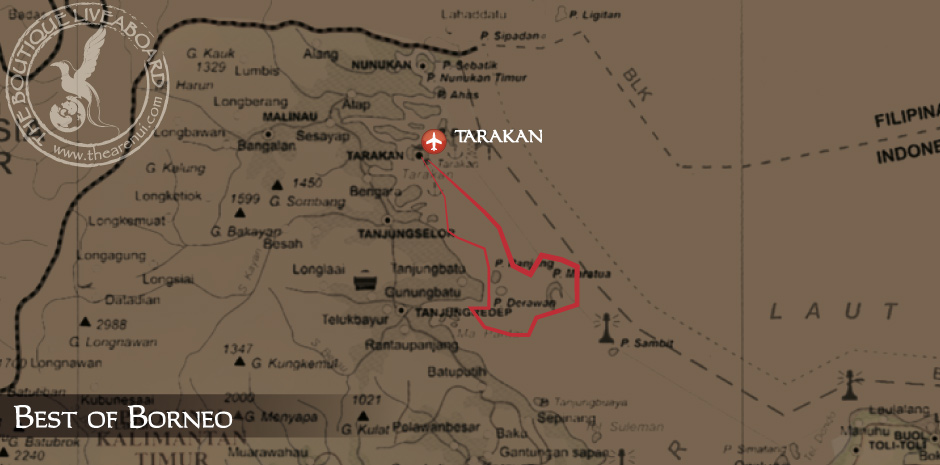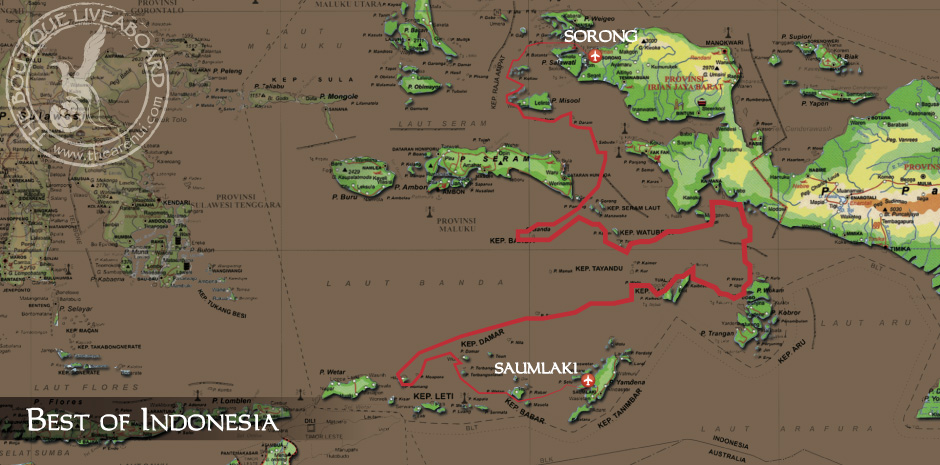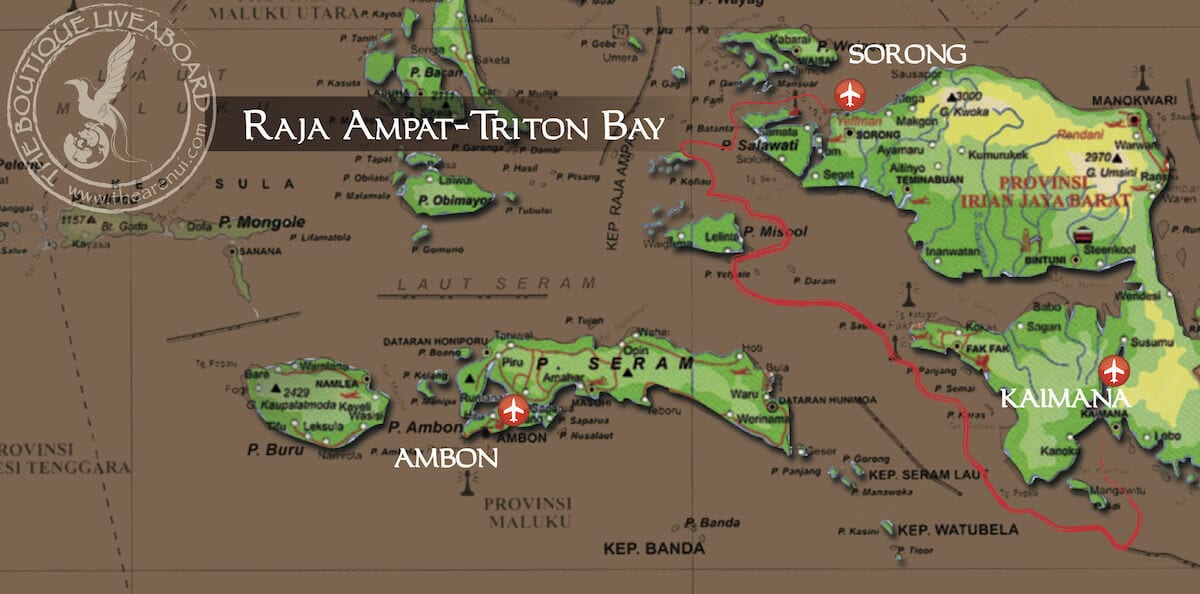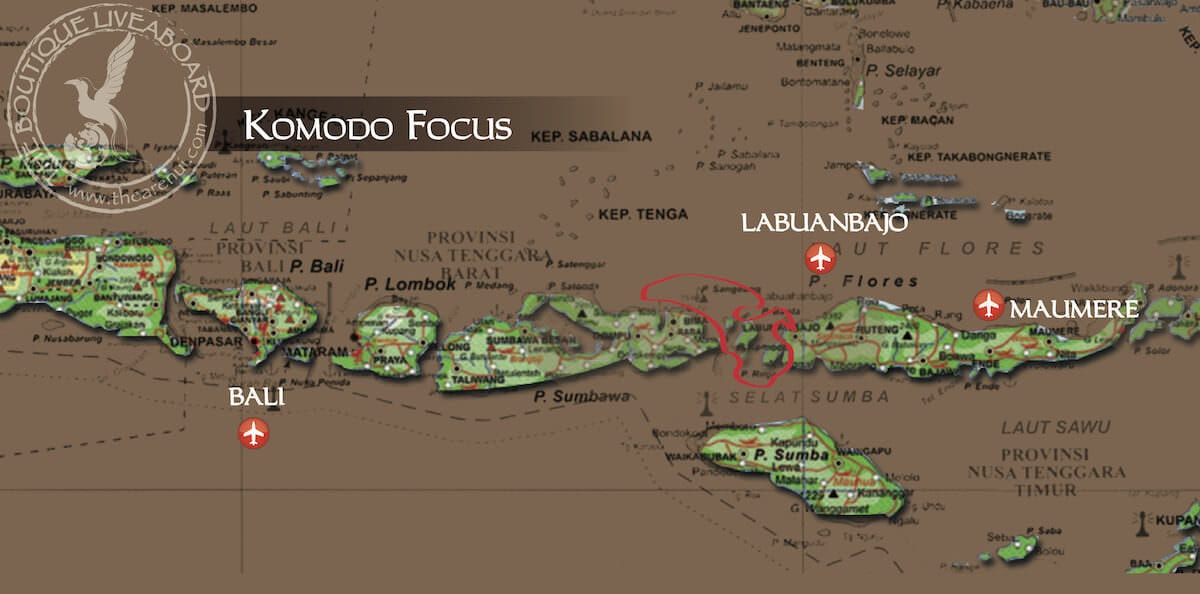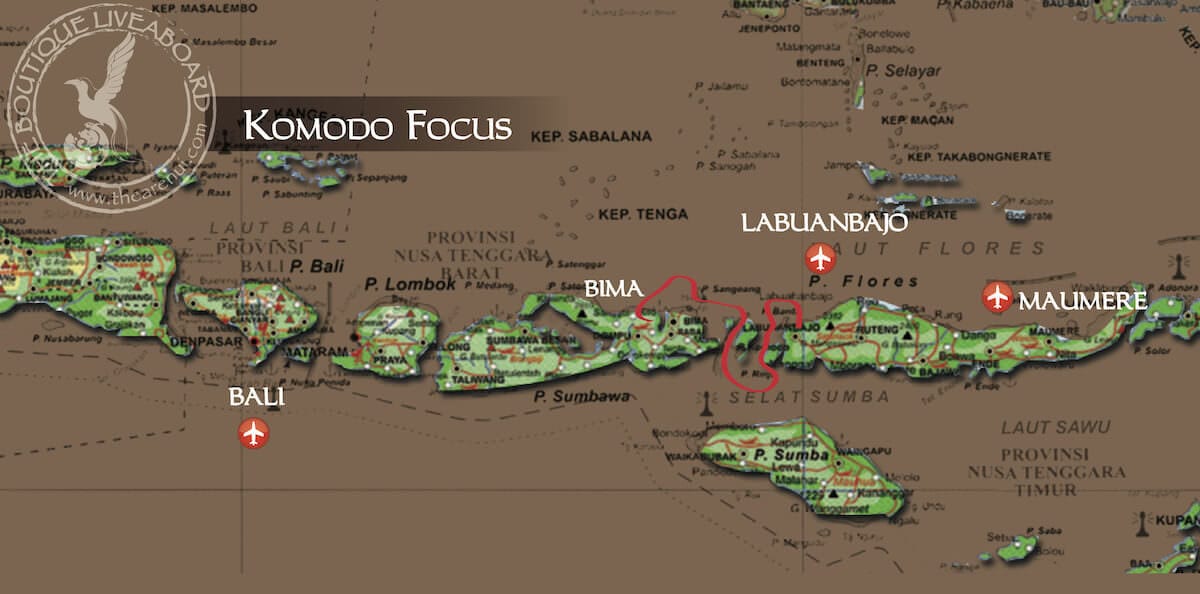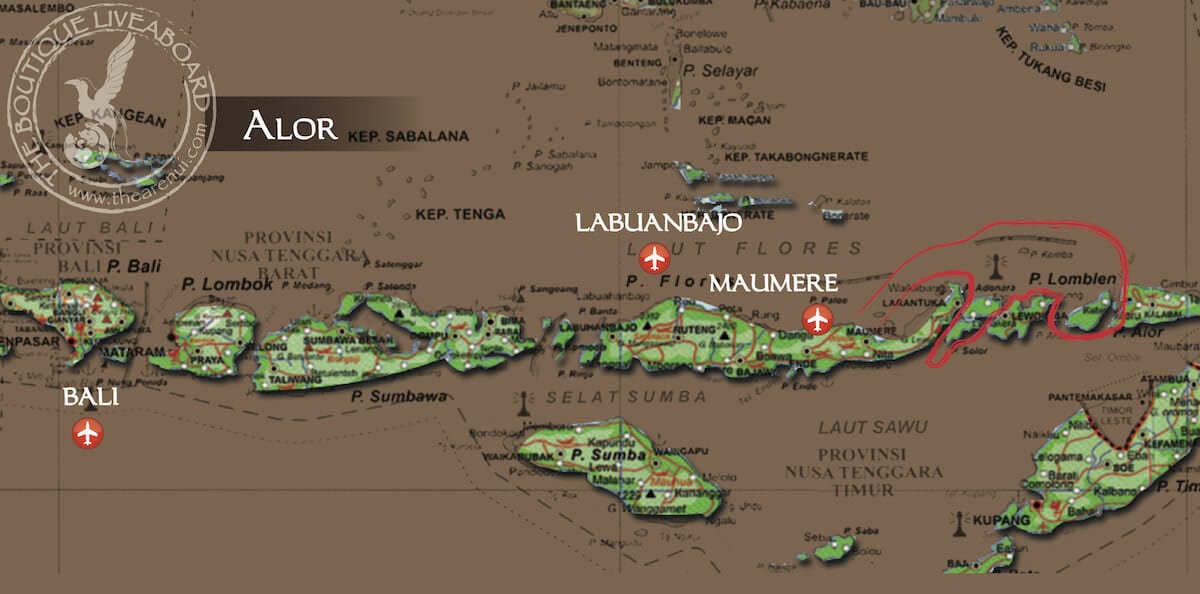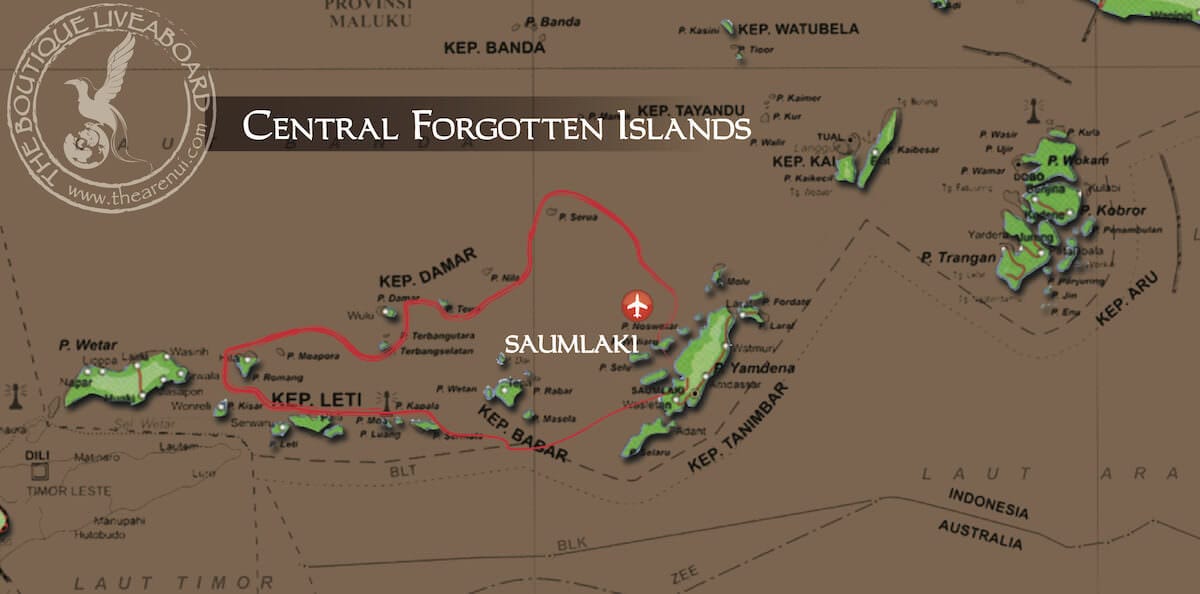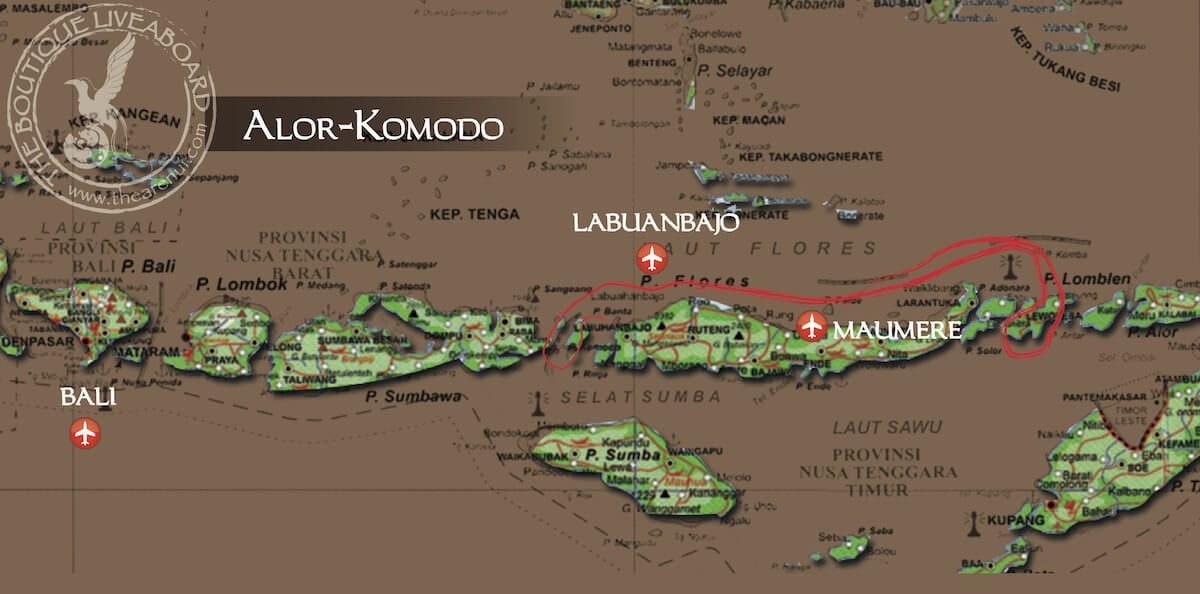BEST OF BORNEO
11 Days/10 Nights Tarakan-Tarakan Cruise Itinerary
Our journey will start and end in Tarakan, located on Tarakan Island. It is one of the major cities in northern Borneo, close to the Malaysian border from Sabah, Malaysia. Tarakan is well connected to Singapore via Balikpapan. Tarakan is also well connected to Bali and Jakarta via Balikpapan.
This 9 day, 8-Night cruise takes us between the islands and reefs rising up from the Makassar Strait. After leaving the coast of Borneo, the ocean floor becomes very deep, very soon. As we continue farther out, a number of incredible coral reefs and islands grow up to the surface from the depths. Nutrient rich currents bring up big fish from the deep into shallower waters, allowing us to see them pursuing reef fish in hope of catching a meal.
Each island has its own unique character. We can see entire schools of manta rays at Sangalaki that are drawn here to feed on plankton. As well as turtles, Derawan has elusive treasures to be found; here we search for hidden critters. Maratua hosts massive marvels, such as sharks, barracudas and more mantas! At Kakaban island, plunge into the saltwater lake full with non-stinging jellyfish in the middle of the island. Dive the incredible walls encircling the island of Kakaban. In the shallow waters encircling Samama, we scan for an abundance of macro critters, hiding in plain sight.
Day 1 Embarkation in Tarakan
Day 2 – Derawan (4 dives)
Part of the Coral triangle, Derawan Islands have one of Indonesia’s richest and diverse ocean life. Not just diversity of Cave dives, wreck dives, muck dives, drift dives, walls, plateaux.
Old Pier
Gets its name, from you’ve guessed it; a pier! As we follow the coral slope down and work our way south and to the east along the shoreline, we can see an abundance of butterfly fish, angels, damselfish, anthias, wrasse, gobies, shrimp and nudis. Perhaps a turtle or two and the blue spotted stingrays and schooling fusiliers are for sure the highlight.
Shark Point
As we descend the coral lope that becomes a drop off. Amongst the crabs, turtles and morays, the big attraction here is the possibility of seeing some sharks along with the impressive sight of schooling jacks.
Blue Trigger Wall
This healthy coral reef slope and wall combination is home to schooling of fusiliers and blue triggerfish. As we go along this comfortable drift, what else is there to see? Batfish, gobies, blennies, shrimp, nudibranch, turtle and shark, all have a good chance to be seen here.
Tuturuga Point
This dive site, a mix of sand and coral is impressive both by day and by night. As well as the usual suspects in this area, it is special for being home to frogfish, leaf fish, scorpionfish, flathead, Blennies, dragonet, octopus and rays.
Day 3 – Kakaban (4 dives)
Kakaban is best known for its non-stinging jellyfish lake, located in the centre of the island, a short walk from the coast. Kakaban was likely uplifted during the Holocene and sea water was trapped turning the area and formed a landlocked marine lake. The water is now a mix of salt water and fresh water from the rain. The non-stinging jellyfish have lived in this lake for hundreds of years with no known predators. Around the coastline of Kakaban island we are offered a large variety of diving, including corals, large pelagic and caves.
Barracuda Point
This exhilarating drift dive takes us along a combination of slope and drop off. We can see abundance of butterfly fish, angels, damselfish, anthias, flatworm gobies and perhaps some sharks and the famous schooling barracuda.
Cabbage Point
This dive site gets its name from the generous amount of cabbage coral coating the seabed. Amongst scorpionfish, moray eels and batfish, we can marvel at schooling fusiliers that almost move almost as if they are one lifeform. We may also come across some blue spotted stingrays along the way.
The Corner
That’s right, it’s located on a corner of the island! As we drift around this mix of slope and steep drop-off along the north eastern coastline, we can see schooling fusiliers, blue spotted stingrays and some mean looking giant trevallies. What else? Butterfly, anthias, surgeon, scorpion, blennies, shrimp, nudis and turtles.
The Wall
Here we can hope to be mesmerized by a huge school of jacks.Leaffish, turtles, sharks, trevallies and tons of reef fish are all possible.
Land excursion: Danau Kakaban – Translates to ‘Kakaban Lake’. Using our tender boats to reach Kakban’s shore, we will take a short walk to the lake’s edge. Here we will snorkel and amongst four species of non-stinging jellyfish. They don’t sting because they have no predators within the lake. The topography is a mix of sand and vegetation with a maximum depth of just 23ft (7m). Here we can also see gobies, shrimp, crab, nudibranch and snakes.
Day 4 – Samana (4 dives)
About 15 min by boat from Sangalaki is another dive location, Samama, perfect for macro. We are likely to see pygmy seahorses and a lot of nudibranchs. The island has a large area of mangrove and the dive sites are all very shallow. Currents are very mild and so we can take some good, long dives. Sunlight filters onto the hard and soft corals illuminating them in a rainbow of color. Reef life is abundant with many schools of fish. Be on the lookout for blue ribbon eels at the edge of the reef. Minute pygmy seahorse can be found camouflaged in gorgonian seafans.
Days 5/6 – Exploratory Diving (8 dives)
Days 7/8 – Maratua (8 dives)
Here we have the chance to see some thrilling big creatures. Some best dives include, “The Channel” and “Big Fish” which has whirling schools of barracuda, grey reef sharks, thresher sharks, masses of turtles and schooling eagle rays schooling.
The East Wall
The two pillars at this site are the remains of a Japanese watch tower after it has been bombed during the Second World War. Here we can find a huge variety of seafans and black corals. The dive starts with a gentle slope that becomes a sharp, almost vertical drop-off. The barrel drum coral here are massive in size. This dive site is also called ‘Eagle-Ray Point’, because eagle-rays are often spotted here.
The Channel
Diving at beginning high tide when the current is flowing into the lagoon. With a considerable current, we can hook onto the reef to look out for eagle rays, barracudas, groupers and sometimes even whalesharks!
Coconut Wall
The drop off takes us along the coast drifting normally in a southeasterly direction. As well as anthias, flatworms, nudis and batfish, we can see schooling snappers and perhaps some sharks and majestic eagle rays.
Lighthouse
Here the drop-off slopes to a sandy bottom. The current here is mild and we can see a big school of batfish and sometimes leopard sharks. In the shallows we can see schools of of grouper and red snapper.
Paradise 123
Along this coral slope we can see…fusilier, sweetlips, butterfly, angel, grouper, damselfish, anthias, batfish, scorpion, blennies, shrimp, crab, nudibranch, turtles, rays and maybe black tipped reef sharks. What would be the ultimate treat to see here? To meet a thresher shark or two!
Kehedaeng
Here along this beautiful fringing coral reef we have the chance to see: Fusilier, Butterfly, Angel, Grouper, Damselfish, Anthias, Scorpion, Blennies, Shrimp, Crab, Nudibranch, Turtle and even Sharks!
Turtle Traffic
Love green sea turtles? This dive is for you! Maybe we can see up to 30 on just one dive. Here we can experience a relaxing drift dive. We also have the chance to see small groups of barracudas, jackfish and stingrays.. Being mindful to look out for critters on the reef. This location is beautiful for macro photography.
Land excursion: Goa Halo Tabung, Maratua Island – We use our tender boats to reach the southwest coast of Maratua where we hop off onto a wooden bridge. We then walk a short half mile to Goa Halo Tabunge (meaning Halo Tube Cave). We are met with beautiful, turquoise, still water which we can enter using steps on the low side of the pool and begin our swim through the cave. Sea water enters through the crevices of the cave, which is why the water here is salty.
Donning snorkeling equipment and buoys, we can enjoy an easy and relaxing float through this tunnel-like cave. Surrounded by the chirping crickets, luscious greenery and tranquil atmosphere, this is a moment to savour.
Days 9/10 Sangalaki (7 dives)
This area is famous for the large population of turtles and manta rays year round and guests will frequently see them feeding. The island has a turtle nursery run by the local government which can be visited. Whale sharks are frequently seen off the coast of the island.
Sandy Ridge
Macro lovers are in for a treat right here. Nudibranch, sea slug, flat worms, and other small critters galore! Butterfly fish, angel fish, and sweet lips are always resident at this site.
Turtle Town
We can expect to find…turtles! As well as unexpected surprises. Napoleon wrasse and cuttlefish. This reef is full of butterfly fish, banner fish, angel fish, surgeon fish, fusiliers, trevally, sweet lips, moorish idol, damsel fish and much more. Paradise for macro lovers too! It’s also a great spot for night dives.
Coral Garden Sangalaki
Here we dive an extremely beautiful and healthy coral reef. We can find a real variety of interesting creatures here including frog fish, crocodile fish, mandarin fish, butterfly fish, angelfish, and mantis shrimp. For those who enjoy macro, we can find tiny critters such as anemone shrimps, coral crabs and sea fan crabs.
Manta Run
Manta rays will rise up from the deeper water, and then after reaching the surface, they will circle around in order to feed on plankton. Manta rays are more often seen during the afternoon. This diving spot has a good reef, good visibility and a wide variety of reef fish.
Manta Parade
As the name suggests, we are very likely to meet a number of mantas here. It’s also a great place for snorkeling with manta ray here as they rise to the surface. Here, mantas are mostly seen from morning to noon. Coral reefs in this area are patchy and here we can find huge schools of fusiliers and surgeon fish. Various gobies and ghost pipe fish can also be found here. If we are lucky, we can also find leopard sharks here!
Eel ridge
This sandy bottomed dive site has a ‘field’ full of sand eel/ghost eel. A very different and surreal diving experience! Visibility is better during the morning to noon compared to the afternoon. We can be lucky to find lobster and mantis shrimp here too.
Manta Avenue
Manta rays can be found swimming on the surface during morning to noon. It is a shallow diving/snorkeling site, with a beautifully healthy reef. Here we swim with butterfly fish, angel fish, surgeon fish, and fusiliers. There’s also the manta beauty salon located here…a secret manta cleaning station, where mantas get cleaned by cleaner fish. The manta will swim gracefully, circling around whilst we enjoy the beautiful underwater scenery.
